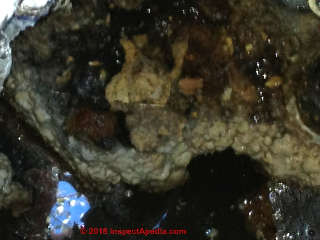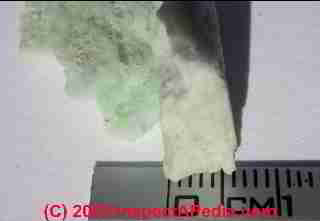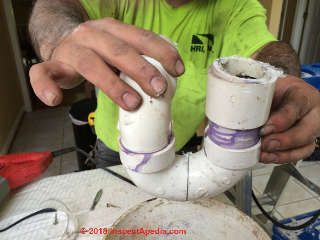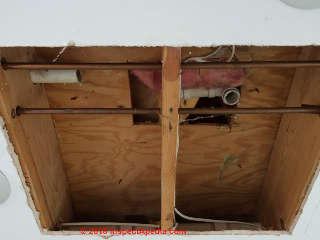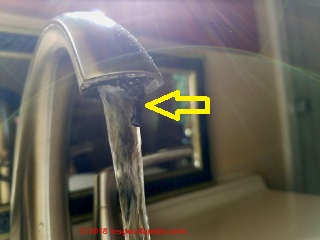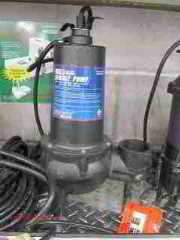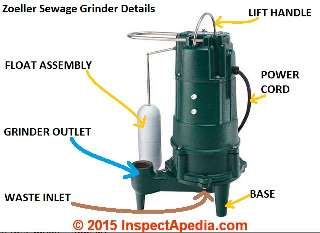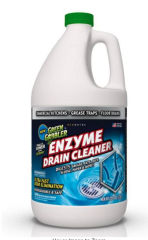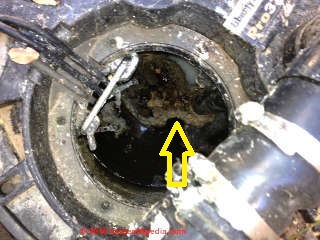 White Waxy Blockage-Clogs in Sewer or Septic Line or Pumps
White Waxy Blockage-Clogs in Sewer or Septic Line or Pumps
Avoid Damage or Fix Sewage Pumps, Septic Pumps, & Grinder Pumps
- POST a QUESTION or COMMENT about septic pump problems, damage, diagnosis, repair
What causes white waxy drain or sewer/septic pump clogs and how do we clean, remove and prevent that clogging?
This discussion is part of our Sewage & septic pump clog or failure causes, diagnosis, repair, prevention guide where white waxy clogging material is included on our warning list of items that will clog drains, toilets, sinks and sewage ejector or septic pumps and grinder pumps.
This article describes the causes of and steps to prevent clogging and/or damage to septic pumps, grinder pumps, and sewage ejector pumps. We include excerpts from sewage or septic grinder pump manufacturers' installation manuals that describe sewage pump diagnosis & repair procedures.
This article series also lists septic and grinder pump types, brands, and will identify pumps that are resistant to damage from debris or objects that may enter the toilet, sewer line, or septic tank.
InspectAPedia tolerates no conflicts of interest. We have no relationship with advertisers, products, or services discussed at this website.
- Daniel Friedman, Publisher/Editor/Author - See WHO ARE WE?
Septic / Sewage Pump Clogs - Soft Waxy Deposits
 Soft drain stoppages: white waxy, gel-like, or scaly or plaster-like clogs in plumbing drains or that form as blockages in septic or sewage ejector and grinder pumps can be caused by several very different problems.
Soft drain stoppages: white waxy, gel-like, or scaly or plaster-like clogs in plumbing drains or that form as blockages in septic or sewage ejector and grinder pumps can be caused by several very different problems.
[Click to enlarge any image]
Here we describe each of the causes and cures for these soft white or gray jelly-like deposits that clog plumbing drain and pumping systems.
We also describe the causes and cures for harder white, gray or tan drain deposits and clogs, and we include notes on some less-common blue, blue-green, and black slime and clogs found in both supply and drain systems.
Detergent or Soap Clogs & Deposits
Question: what is the white waxy stuff that caused my septic pump float switch to stick & clog up leading to failure of my septic pump?
What do you suppose was the large white waxy clumpy substance that I found recently in my septic pump container? The sticky substance was stuck to the sides of the tank (where it was several inches thick).
It was also stuck all over the septic pump, and stuck all over the float switch - .which of course was the problem and the reason for opening the tank.
This accumulation happened over 2 years and 5 months.
thanks. - Rani 8/11/11
[Click to enlarge any imagbe] Photo: white waxy deposit clogging the inlet of a sewage ejector pump - InspectApedia.com photo from an anonymous reader.
Reply: soaps or detergents can form white waxy clogging deposits in drain pipes and sewage or effluent pumps
Rani,
We're not sure. Sorry but our forensic lab no longer accepts sewage slime deposits for analysis and identification, though some larger biological labs and water / sewage testing laboratories can provide that service.
Here are the common causes of white or gray slimy deposits in sewer piping, drains, septic or sewage pumps, and septic tank inlet baffles:
Bio-Slime or Bio-Film Bacterial Growth & Slime Drain & Sewge Pump Clogs
 Some white waxy clogging material found in plumbing systems can be caused by bacterial growth, fungal growth including yeasts, and other organisms forming a waxy slime.
Some white waxy clogging material found in plumbing systems can be caused by bacterial growth, fungal growth including yeasts, and other organisms forming a waxy slime.
Eboigbodin (2008), and McBain (2003) as well as many other researchers cite the role of bacteria and fungi in the formation of biofilm slimy deposits in water supply and drain piping systems.
Photo: Zupančič et als. (2016) investigated the diversity of fungi detected in residential dishwashers, cited in detail at the end of this article.
Several factors have been shown to favor biofilm formation in water distribution systems, including the capability of bacteria to resist disinfectants, improper use of disinfectants, the nature and concentration of biodegradable substances, temperature, and plumbing materials. Eboigbodin (2008)
Common among the biofilm organisms are the fungus Fusarium sp. often detected in plumbing drains (Short 2011), Pseudomonas aeruginosa, other bacteria, as well as yeasts such as Rhodotorula mucilaginosa (usually red or orange) or Exophiala dermatidis (a black yeast) spread from dishwashers to kitchen. - Zupančič 2016
... dishwasher waste water contained E. dermatitidis, Exophiala oligosperma and Sarocladium killiense. - Zupančič
Bacterial growth clogging in a drain line, drain trap, or in an ejector pump or sewage pump can be aggravated by extra sources of bacteria such as bacteria forming in air conditioning condensage dispensed-of by dripping it through the condensate drain system into a seldom-used trap or sewage pump chamber.
If this is the cause, cleaning the system with a simple household cleaner or disinfectant can usually remove the problem.
Vinegar, enzyme cleaners and most drain cleaners will remove typical bacterial slime deposits and clogs.
Also see our notes below about the formation of greasy gelatinous blobs formed from waxes and oils.
Detergent Powder Drain & Pump Clogs
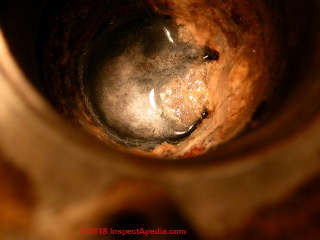 Excessive use of powdered detergent in washing machines or dishwasher & white waxy deposits
Excessive use of powdered detergent in washing machines or dishwasher & white waxy deposits
A good guess is that your sewage ejector tank or septic tank that uses a septic pump was clogged by someone who used too much powdered detergents in a clothes washer or dishwasher.
It's well established that using excessive amounts of powdered detergent in a dishwasher or clothes washer can lead to accumulation of a gooey mess that clogs drains or even septic drainfields. Some bar soaps can also form waxy clogs or blockages in plumbing systems and sewage or effluent pumps.
Also see DISHWASHER & LAUNDRY DETERGENTS CONTAINING PHOSPHATES & SURFACTANTS for a discussion of the effects of phosphates & detergents on the environment.
Other waxy gray or white soap deposits
You have provided another important example: excessive detergent use OR using a budget detergent that contains large amounts of clay fillers can clog the pump float control switch or the pump intake in a sewage ejector pump or sewer pump as well.
Some soaps are more likely to cause waxy clogs than others. Soaps are produced by using an alkali to convert fats (animal or vegetable) to a combination of soap and glycerol.
Soaps produced using sodium hydroxide are referred to as "hard" soaps that are more-difficult to dissolve in water, while soaps produced using potassium hydroxide tend to be more-easily soluble and are thus called "soft" soaps.
Soft soaps as well as soaps made from a petroleum base (shower gels, for example) tend not to clog drains.
We discuss detergent choices & recommendations to minimize drain and septic problems in two locations.
Drywall Dust or Plaster Clogs in Drain Systems
Yep it's true, some fools dump plaster or drywall dust and debris down toilets or other drains while cleaning up after a plastering or drywall installation or repair job.
Don't do that. Both plaster and drywall dust will form a hard-to-remove drain blockage in nearby traps or drain lines. While acid-based drain cleaners might remove such blockages more-likely you'll need to use a power snake or other mechanical drain cleaning system.
Grease-Cake Clogging
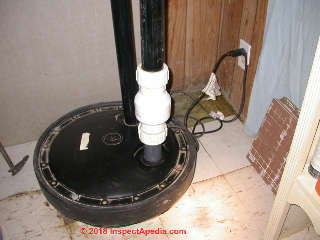 Fats and oils entering the drain system or pump chamber where they solidify to form greasy white, gray, or deposits
Fats and oils entering the drain system or pump chamber where they solidify to form greasy white, gray, or deposits
Other waxy clogging can be traced to soaps and detergents: this second common cause of waxy deposits that clog pumping chambers or piping are fats and oils that were flushed down drains.
These greasy deposits may be white, tan, brown, or even near-black substances that form a gelatinous, greasy, or waxy deposit or blob.
Even if you take care to avoid pouring grease and oils directly into your drains (don't do that), the fats and oils that are deposited on dishes from the normal consumption of a wide range of foods will be sent into the drain system from your kitchen sink or your dishwasher.
For residential drains and pump suffering from fat or oil clogging waxy deposits, plumbing drain FOG (Fat Oil Grease) degreasers (such as Cloroben PT-4) may help dissolve the clog.
See the example MSDS safety sheet for Cloroben PT4, given below. Cloroben PT4 is a plumbing drain cleaner also described as a "flow improver" and "grease control agent" produced and marketed by Hercules. As pointed out by Hughes (1954) often safety has focused first on explosion or fire hazards.
- CLOROBEN PT4 SAFETY DATA SHEET, [PDF], HCC Holdings, Inc. an Oatey Affiliate, 4700 West 160th Street Cleveland, OH 44135, USA, retrieved 2017/02/22, original source: http://www.oatey.com/msds/sds-us--hercules-cloroben-pt4.pdf
- CLOROBEN PT-4 Product Specifations Sheet, [PDF] Op. Cit. http://www.oatey.com/doc/pt4.pdf
Cloroben PT-4 can be used to improve flow of gravel absorption beds around cesspools, drywells, leach tanks and drain field laterals.
Can be used to clean lines to and from grease traps, cleans main lines or soil stacks/vents of apartment buildings, condominiums and hotels or for commercial applications; controls grease caking and fouling in clarifiers, lines and digesters and helps maintain good percolation in aeration basins of municipal waste treatment plants.
Some Hercules products such as Hercules PT-GIO1™ combine grease solvents and "waste disgesting bacteria" while Hercules PT-4 (or Cloroben PT-4) is a formlua designed to rapidly dissolve FOG (Fats Oils and Grease) using a non-acidic, non-caustic formula that is described as "safe on all types of piping materials when used as directed"
- Hercules PT- and WHAM Product literature: http://www.oatey.com/doc/lcs982greasecontrolwhampt4ptbiocanadapdf081015.pdf (op cit)
- Watch out: Hot water + vinegar diluted 1:1 can help remove grease clogs but risks simply pushing the clog further down the drain/waste piping system where it forms a new, harder-to reach drain blockage.
Watch out: never use industrial metal cleaning chemicals or oil/wax removers in plumbing or septic systems. Details are
at DEGREASING SOLVENTS IMPACT on SEPTIC
Mineral Scale Clogged Drains & Sewage or Ejector Pumps
Mineral scale formation can form hard white, gray or orange deposits
If your water is "hard" or high in calcium or magnesium that condition, combined with those types of soap particularly invites the formation of waxy white blobs that clog drains, traps, and septic pumps.
For modest scale deposits pouring vinegar into the trap or sewage pump and letting it sit for a few hours can soften and dissolve the clog blockage.
Watch out: For larger and harder scale formation, a scale removing chemical treatment may work but risks environmental contamination if your building is connected to an onsite waste disposal system - private septic tank and drainfields.
Be sure to review the manufacturer's literature about permitted uses of such chemicals.
Mineral scale can also clog water supply pipes, valves, and vaucet strainers, as illustrated by our photo just below.
See these articles about mineral scale formation, removal, prevention in water supply and drain systems:
HOT WATER PRESSURE IMPROVEMENT
WATER HEATER SCALE DE-LIMING PROCEDURE
Paraffin or other wax clogs in drains
A reader contacted us to discuss the removal of actual paraffin that her daughter had poured into the drain system.
We advised against using very aggressive chemicals because of the hazards involved, the risk of damage to the drain system, and the low chance of success.
Any chemicals we could find that would dissolve paraffin were in our opinion too dangerous for home use.
Her plumber cut-out and replaced the clogged trap as well as the most-clogged nearby PVC drain lines and physically removed wax deposits in the downstream drain opening.
See BLOCKED DRAIN REPAIR METHODS for a detailed step by step guide to un-blocking clogged drains. Articles at that page also assist in diagnosing the location and cause of drain blockages.
Also see CLOGGED DRAIN DIAGNOSIS & REPAIR.
Blue Slime Clogs in Supply or Drain Piping
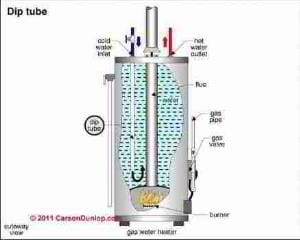 Blue or blue-green slimy clogs found in a water supply or drain system, particularly at a water heater or in hot water piping may be caused by the combination of an alkaline water supply and the use of an aluminum anode in the water heater tank.
Blue or blue-green slimy clogs found in a water supply or drain system, particularly at a water heater or in hot water piping may be caused by the combination of an alkaline water supply and the use of an aluminum anode in the water heater tank.
The chemical reaction between the alkaline water and the aluminum surface of the water heater anode forms a gelatinous greenish blue or blue-gray aluminum hydorxide deposit that can block hot water piping and that may even show up in some building drain systems.
If you suspect that your water heater is providing blue-green jelly blobs check the condition of the water heater anode to confirm that source.
Aluminum anodes are used in water heaters to replace the standard magnesium anode where the local water supply is high in sulphur. That's to avoid a problem with the formation of hydrogen sulfide gas in the water heater - a rotten egg smell.
You may need to replace the worn, corroded anode rod in your water heater and you may need to have your water tested and if it's sufficiently alkaline, you may need to install a water treatment system.
See ANODES & DIP TUBES on WATER HEATERS.
Here Carson Dunlop Associates' sketch above shows the location of the sacrificial anode or dip tube on an electric water heater.
Black Bio-Slime Clogs in Supply or Drain Piping
Not discussed in detail here but included for completeness are bacterial or fungal / mold-formed slime deposits that can clog fixtures, faucets, supply piping and drains.
The black blob shown in our photo was not examined in our lab (though I should have done so) but might include Exophiala dermatidis (a black yeast) that we discussed above at biofilm formation.
To clean and remove the black slimy faucet clog/blob shown in our photo above we used a common household spray cleaner first, then removed the faucet strainer to soak it in vinegar to remove a remaining deposit of mineral scale.
Causes, Cures & Prevention of White Waxy Clogs: Biofilms and Greasy Waxy Deposits in Drain Pipes & Pumps
- Bédard, Emilie, Michèle Prévost, and Eric Déziel. "Pseudomonas aeruginosa in premise plumbing of large buildings." MicrobiologyOpen 5, no. 6 (2016): 937-956.
Abstract:
Pseudomonas aeruginosa is an opportunistic bacterial pathogen that is widely occurring in the environment and is recognized for its capacity to form or join biofilms. The present review consolidates current knowledge on P. aeruginosa ecology and its implication in healthcare facilities premise plumbing.
The adaptability of P. aeruginosa and its capacity to integrate the biofilm from the faucet and the drain highlight the role premise plumbing devices can play in promoting growth and persistence.
A meta‐analysis of P. aeruginosa prevalence in faucets (manual and electronic) and drains reveals the large variation in device positivity reported and suggest the high variability in the sampling approach and context as the main reason for this variation.
The effects of the operating conditions that prevail within water distribution systems (disinfection, temperature, and hydraulic regime) on the persistence of P. aeruginosa are summarized.
As a result from the review, recommendations for proactive control measures of water contamination by P. aeruginosa are presented. A better understanding of the ecology of P. aeruginosa and key influencing factors in premise plumbing are essential to identify culprit areas and implement effective control measures. - Eboigbodin, Kevin E., Allyson Seth, and Catherine A. Biggs. "A review of biofilms in domestic plumbing." Journal‐American Water Works Association 100, no. 10 (2008): 131-138.
Abstract:
Several factors have been shown to favor biofilm formation in water distribution systems, including the capability of bacteria to resist disinfectants, improper use of disinfectants, the nature and concentration of biodegradable substances, temperature, and plumbing materials.
To date, most research relating to drinking water biofilms has focused on the materials that make up the distribution system before water enters the consumers— plumbing systems.
However, drinking water should also meet the necessary quality requirements at the point of consumption even though domestic plumbing systems are usually not constructed from the same materials that are used to construct distribution systems.
This article provides a review of the current literature related to the analysis of biofilms found or produced in domestic plumbing systems and highlights the microorganisms identified as well as causes and strategies for control. - Fleming, I. R., and R. K. Rowe. "Laboratory studies of clogging of landfill leachate collection and drainage systems." Canadian Geotechnical Journal 41, no. 1 (2004): 134-153.
- Flemming, H-C. "Biofouling in water systems–cases, causes and countermeasures." Applied microbiology and biotechnology 59, no. 6 (2002): 629-640.
Abstract:
Biofouling is referred to as the unwanted deposition and growth of biofilms.
This phenomenon can occur in an extremely wide range of situations, from the colonisation of medical devices to the production of ultra-pure, drinking and process water and the fouling of ship hulls, pipelines and reservoirs.
Although biofouling occurs in such different areas, it has a common cause, which is the biofilm. Biofilms are the most successful form of life on Earth and tolerate high amounts of biocides.
For a sustainable anti-fouling strategy, an integrated approach is suggested which includes the analysis of the fouling situation, a selection of suitable components from the anti-fouling menu and an effective and representative monitoring of biofilm development. - El-Dalatony, Marwa M., Byong-Hun Jeon, El-Sayed Salama, Mohamed Eraky, Won Beom Kim, Jihoon Wang, and Taewoong Ahn. "Occurrence and characterization of paraffin wax formed in developing wells and pipelines." Energies 12, no. 6 (2019): 967.
Excerpt:
The wax precipitates form deposits on pipe walls, causing difficulties in … 44% which would crystallize and precipitate during extraction and transportation, and cause higher
oil … The concentration gradient causes a diffusion of waxy compounds from the bulk oil - Husain, Iman AF, an Fahmi Alkhatib Ma, Mohamed Saedi Jammi, Mohamed ES Mirghani, Zaki Bin Zainudin, and Asif Hoda. "Problems, control, and treatment of fat, oil, and grease (FOG): a review." Journal of oleo science (2014): ess13182.
Abstract:
Presence of fat, oil, and grease (FOG) in wastewater is an ever-growing concern to municipalities and solid-waste facility operators. FOG enters the sewer system from restaurants, residences, and industrial food facilities. Its release into the sewer system results in a continuous build-up that causes eventual blockage of sewer pipes. Several researchers have investigated FOG deposition based on the local conditions of sewers and lifestyle.
This paper attempts to review the physical and chemical characteristics of FOG, sources of FOG, and potential chemical and biological reactions of FOG. The effect of the aforementioned factors on the FOG-deposition mechanism is also discussed.
Moreover, insight into the current control and treatment methods and potential reuse of FOG is highlighted. It is expected that this review would provide scientists and the concerned authorities a holistic view of the recent researches on FOG control, treatment, and reuse. - McBain, Andrew J., Robert G. Bartolo, Carl E. Catrenich, Duane Charbonneau, Ruth G. Ledder, Alexander H. Rickard, Sharon A. Symmons, and Peter Gilbert. "Microbial characterization of biofilms in domestic drains and the establishment of stable biofilm microcosms." Applied and Environmental Microbiology 69, no. 1 (2003): 177-185.
Abstract:
We have used heterotrophic plate counts, together with live-dead direct staining and denaturing gradient gel electrophoresis (DGGE), to characterize the eubacterial communities that had formed as biofilms within domestic sink drain outlets. Laboratory microcosms of these environments were established using excised biofilms from two separate drain biofilm samples to inoculate constant-depth film fermentors (CDFFs).
Drain biofilms harbored 9.8 to 11.3 log10 cells of viable enteric species and pseudomonads/g, while CDFF-grown biofilms harbored 10.6 to 11.4 log10 cells/g.
Since live-dead direct staining revealed various efficiencies of recovery by culture, samples were analyzed by DGGE, utilizing primers specific for the V2-V3 region of eubacterial 16S rDNA. These analyses showed that the major PCR amplicons from in situ material were represented in the microcosms and maintained there over extended periods.
Sequencing of amplicons resolved by DGGE revealed that the biofilms were dominated by a small number of genera, which were also isolated by culture. One drain sample harbored the protozoan Colpoda maupasi, together with rhabtidid nematodes and bdelloid rotifers.
The microcosm enables the maintenance of stable drain-type bacterial communities and represents a useful tool for the modeling of this ecosystem. - Short, Dylan PG, Kerry O'Donnell, Ning Zhang, Jean H. Juba, and David M. Geiser. "Widespread occurrence of diverse human pathogenic types of the fungus Fusarium detected in plumbing drains." Journal of Clinical Microbiology (2011): JCM-05468.
- Zupančič, Jerneja, Monika Novak Babič, Polona Zalar, and Nina Gunde-Cimerman. THE BLACK YEAST EXOPHIALA DERMATITIDIS AND OTHER SELECTED OPPORTUNISTIC HUMAN FUNGAL PATHOGENS SPREAD FROM DISHWASHERS TO KITCHENS [PDF] PLoS One 11, no. 2 (2016): e0148166. Retrieved 2018/07/04, original source: http://journals.plos.org/plosone/article?id=10.1371/journal.pone.0148166 Creative Commons Lic.
Abstract:
We investigated the diversity and distribution of fungi in nine different sites inside 30 residential dishwashers. In total, 503 fungal strains were isolated, which belong to 10 genera and 84 species. Irrespective of the sampled site, 83% of the dishwashers were positive for fungi.
The most frequent opportunistic pathogenic species were Exophiala dermatitidis, Candida parapsilosis sensu stricto, Exophiala phaeomuriformis, Fusarium dimerum, and the Saprochaete/Magnusiomyces clade.
The black yeast E. dermatitidis was detected in 47% of the dishwashers, primarily at the dishwasher rubber seals, at up to 106 CFU/cm2; the other fungi detected were in the range of 102 to 105 CFU/cm2. The other most heavily contaminated dishwasher sites were side nozzles, doors and drains.
Only F. dimerum was isolated from washed dishes, while dishwasher waste water contained E. dermatitidis, Exophiala oligosperma and Sarocladium killiense.
Plumbing systems supplying water to household appliances represent the most probable route for contamination of dishwashers, as the fungi that represented the core dishwasher mycobiota were also detected in the tap water.
Hot aerosols from dishwashers contained the human opportunistic yeast C. parapsilosis, Rhodotorula mucilaginosa and E. dermatitidis (as well as common air-borne genera such as Aspergillus, Penicillium, Trichoderma and Cladosporium).
Comparison of fungal contamination of kitchens without and with dishwashers revealed that virtually all were contaminated with fungi. In both cases, the most contaminated sites were the kitchen drain and the dish drying rack.
The most important difference was higher prevalence of black yeasts (E. dermatitidis in particular) in kitchens with dishwashers. In kitchens without dishwashers, C. parapsilosis strongly prevailed with negligible occurrence of E. dermatitidis. F. dimerum was isolated only from kitchens with dishwashers, while Saprochaete/Magnusiomyces isolates were only found within dishwashers.
We conclude that dishwashers represent a reservoir of enriched opportunistic pathogenic species that can spread from the dishwasher into the indoor biome.
Watch out: at SEPTIC & SEWAGE PUMPS we explain that choosing the wrong type of pump, such as installing a simple basin pump or effluent pump (designed to handle primarily liquid waste) on a system where blackwater (toilet waste) is entering the system is likely to lead to pump clogging and failure.
Toilet Paper Clogging of Grinder Pumps?
Question: toilet paper clogs grinder lift pump?
[Click to enlarge any image]
Illustation: main parts of a sewage grinder pump, adapted from Zoeller's Shark series 803-805-807.
2016/04/05 Thomas Guastavino said:
We have a Zoelner grinder lift pump that recently clogged with toilet paper when to wrapped around the impeller. Are there any recommendations for what type of TP is best to prevent these types of problems?
Reply:
Thomas I've been testing toilet paper breakdown rates with some tests running continuously since 2009; my OPINION is that most toilet papers break down without issue witin a septic tank itself - changing the paper brand won't reliably fix the problem you encountered.
The grinder pump is going to run before most toilet papers will have separated into small fragments.
So I suspect there's a different problem: the grinder - tampons, or some other stuff can clog up sewage pumps. (Dental floss is one of the worst offenders and it's hard to keep that out of the pump).
Zoeller indicates quite clearly that their residential sewage grinder pumps, such as the Zoeller Shark 803/805/807 Residential Grinders can handle "all flushable wastes" - to me that means feces and toilet paper but not tampons and probably not dental floss.
Are we sure you have the right pump type and model installed. Sometimes people install a de-watering sump pump or a simple effluent lift pump where a grinder pump is needed.
If you have the right type and model of pump installed, check the pump inlet openings to be sure that there is no damage there.
Watch out: at SEPTIC & SEWAGE PUMPS we explain that choosing the wrong type of pump, such as installing a simple basin pump or effluent pump (designed to handle primarily liquid waste) on a system where blackwater (toilet waste) is entering the system is likely to lead to pump clogging and failure.
...
Reader Comments, Questions & Answers About The Article Above
Below you will find questions and answers previously posted on this page at its page bottom reader comment box.
Reader Q&A - also see RECOMMENDED ARTICLES & FAQs
On 2021-05-13 by (mod) white pasty clog found in toilet - removed using a drain cleaner
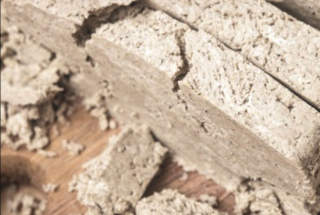 Na'ilah
Na'ilah
White waxy clogs in sewer lines are often caused by oil, grease, fats being dumped down drains, and on occasion by coagulated soap or soap powder.
The clog can also be formed as a bio-film described in the article above on this page.
An enzyme drain cleaner isn't harmful, if used according to directions, but for thick clogs usually mechanical cleaning is what's needed.
Take care using hot water to "de-clog" a toilet bowl as there's a risk of cracking the porcelain, and mixing bleach and very hot water could also cause burns or eye injury.
On 2021-05-13 by Na'ilah
RE-posted with dis-allowed link converted to image
- Ed.
I just removed a toilet and found buildup in toilet drain pipe (along back side of pipe about 1" think near flange and tapers to nothing at elbow).
It was chalky and easy to remove (I did pour an enzyme drain cleaner over it 24 hour prior to trying to scrape it away. It was pasty, off white stuff just like like the halva in this pic -
Any thoughts about what this might be clinging from the edge of the flange to the drain pipe about 10" down?
(it's not waxy, my water is hard, but this is the only drain that I know it is in - my husband usually cleans toilet bowl w/ hot water and bleach if that makes any difference) Thanks!
On 2021-03-09 by (mod) - wax clogging at sewage pumps where an HE Washing Machine is in use
@John James, Thank you for this photo and posting.
Causes and types of white waxy clogs in sewage pumps, pipes, systems.
Waxy clogs in sewage pumps are a common complaint that we've seen for years; usually the manufacturers say we're sending too much grease or fats and oils into the system OR using too much dry powder detergent but indeed it seems that at least sometimes something else is going on, possibly in some cases the formation of a biofilm.
I've had trouble researching this topic because "clog" and "sewer" drowns the search engine results. I'm still working on it and if I can find more references and causes and cures than those already listed on this page I'll add them here; and of course we welcome your further comments or questions or suggestions.
For other readers: a "HE washer" refers to a "High Efficiency Clothes Washing Machine:.
These units use much less water during their wash cycle.
It is possible that a result of using a high efficiency washing machine is a concentration of soap and dirt combined with fabric fibers released by the wash process along and biological debris in their wastewater to form semi-solid clogs.
Watch out: if you find toilet paper in that white sewage pump clog then I suspect the wrong type of pump is installed in your home - you need a grinder pump not a simple effluent pump.
In the home where the Samsung HE clothes washer shown below has been in use for about 5 years, the owners report no clogs in its drain system; only liquid detergent is used, and the average use is about 2 washer loads per day.
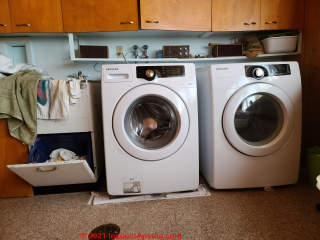
James I wanted to add that if you find toilet paper in that white sewage pump clog then I suspect the wrong type of pump is installed in your home - you need a grinder pump not a simple effluent pump.
On 2021-03-09 by John James - Tide HE turbo, that has faster dissolving suds - may reduce white clogging at sewage pump?
I thought getting a HE washer was a good idea...until, after 3 years of usage my sewage ejector pump failed. It didn't really fail; it was prevented from running because the float switch was blocked from starting the pump by an accumulation of white matter. The white matter seems to be a soap build up. We have diligently used an HE liquid and recently the powder, both in the right amounts.
It has failed twice; 3 years since the last time and this time. I found that the Tide company has come up with a new product, Tide HE turbo, that has faster dissolving suds; hopefully that will help. I have noted other folks are having a similar problem, but I want to learn what the fix is.
I am thinking about buying an older washer as this problem seems consistent with the new HE washer.
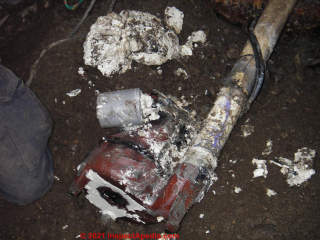
On 2020-11-03 - by (mod) -
Are we discussing a sewage pump or an effluent pump? If it's enough fluid pump you a protected with a filter
If it is a sewage pump and it's clogging with toilet paper then it's not the right type of pump, you need a grinder pump
On 2020-11-02 by JERRY
How can I keep my float free of things like toliet paper and laundry lint?, I dont want to have to go down a clean the ejector pump and float every month
On 2020-07-02 by (mod)
Jon
That could be grease or detergent.
On 2020-07-02 by Jon
My septic tank filter has to be cleaned every month or it becomes completely clogged by what appear to be white seeds that float on the surface of the effluent. I have noted when these dry they are easily crushed into a powder. We do have calcium in our water. Has anybody else experienced this?
On 2020-06-18 by (mod) - Green Gobbler drain opener vs sewage pumps?
Vince
Green Gobbler is a drain opener produced and sold by the company called Telebrands. It is said to be safe for all pipes and EPA-approved.
From that excerpt from company's product description one would assume that used at normal household usage levels and as recommended by the manufacturer the drain cleaner would not harm a septic system because we expected to be sufficiently dilute in the septic tank
On 2020-06-18 by vince
will the green goobler damage sewer ejection pumps
On 2019-11-07 by (mod)
Raj
Indeed this is a common problem with sewage grinders; unfortunately since it's so difficult to change human behaviour the most-effective solution is a combination of filter screening and a change of the sewage grinder pump model for a macerating unit rated to grind up or tolerate small fabrics, tampons, &c.
Take a look at the sewage grinder pump articles in the More Reading links above and you'll see this problem discussed as well as note of types of commercial grinders that can handle most obstructive materials.
On 2019-11-05 by Rajkumar
Dear All,
In my apartment the sewage grinder motor is stuck at times since some residents are throwing solid wastes into the toilets and at the end the motors are getting damaged . Can you please help how to find the resident and also requesting you provide a permanent prevention solution to avoid any of such issues in future .
Appreciate your help in this in advance.
On 2018-07-03 by (mod) - problem with the white waxy buildup.
Craig,
I'm not sure what forensic or biological lab can perform the test you require. You might give a call to EMS Lab or some of the other larger biological laboratories and also check with your local water testing labs to see if they're able to examine a sample.
There are several common causes of white waxy build-up that can appear in a sewage ejector pump, in drain piping, and occasionally at the septic tank baffles.
Usually we trace the substance back to either a bacterial growth combined with fats and greases that occur naturally in wastewater (even if you're not consciously pouring fats and oils down your drain those derive simply from washing dishes on which a range of foods has been served);
or completely differently: white deposits may be traced excessive use of powdered detergents.
See details
at WAXY BIOFILM SLIME CLOGS in DRAINS & PUMPS
On 2018-06-28 by Craig baker
I have a problem with the white waxy buildup.. where can I send a.sample for free analysis to see what it is?.. thank you
Question: sewage pump runs too much or won't shut off
(Aug 10, 2011) dave said:
i dont like the idea of these sewer ejection pumps as they suck electricity, i feel my builder dug the foundation too deep and therefore stuck me with this annoyance on my new home.
it seems to be not working right now after 8months i am an was not pleased to find out this had to be used as i was not told of it until it was put in already. sucks electricity and watever else.
(Aug 16, 2011) Heather said:
Our enjector sewage pump will not shut off even when there is nothing going into it - what do we do to fix this
(July 11, 2012) nancy said:
We lost electricity for several days and now the grinder pump keeps coming on every 15 mins or so, even when nothing is being used, like in the middle of the night. What might be causing it to run so frequently?
(Mar 16, 2013) Anonymous said:
I have an ejector pump that is continously running. Quite possibly a bad switch. Will it hurt to turn off fr the entire weekend until calling a plumber after the weekend. I cannot remove top to inspect. Thanks in advance for advice.
(July 23, 2014) Cindy N said:
The air hole on our sewage ejector pump keeps clogging then the pump won't shut off
Reply: advice for sewage pumps or ejector pumps that won't shut off
Dave and Heather, I've posted answers to your questions and links to related information in the beginning of the sewage ejector pump Q&A section just above. We welcome your further comments, experience with pump repairs, or questions that may arise.
(Aug 17, 2011) Heather said:
Thank you but how to I get to the pump. there are 2 pipes going into my sewage tank and it looks like a sealed lid on it. Does my husband disconnect the pipes?
Reply:
(Aug 18, 2011) (mod) said:
Heather, then your sewage pump is inside the receptacle that receives wastewater from the downstairs fixtures you cite. The procedure is the same: the wastewater receptacle is opened to expose and remove/repair the pump or float switch. With the same safety hazards except that a typical in-house grinder pump receptacle is too small to fall into except as a child hazard.
If the septic pump is inside the septic tank the tank will need to be opened. Be SURE to read over
And the pump can usually be lifted out of the tank by lifting on a handle or chain designed for that purpose. Don't lift a sewage pump by its wiring.
It may be that you'll need to have a septic repair company come out and pump out the septic tank to inspect what's going on, remove and fix the float, and restore the pump and cover.
It's not something you should attempt alone, for reasons I describe at SEPTIC & CESSPOOL SAFETY
Keep us posted on what you find - it'll help other homeowners.
Anon,
I'd turn off the pump rather than let it run continuously - to avoid burning up the pump. But keep in mind that you'll have to turn it on manually when using the fixtures that the pump serves -else you risk a sewage backup.
Question: sewage pump life
(Sept 30, 2011) Red said:
Woulf you be so kind to advise the life expectancy of a sewage pump for a residential home? Is the homeowner responsible for the repair/replacement of same? Would this be covered under homeowner insurance when malfunctioning? Just had to replace mine for $3400.
I was not quite ready for such an expense (who is?). Just making sure I am covering all bases. My home is nine years old and is only occupied by myself. I most appreciate your advices
Reply:
Red, if we take a look at the warranty period for sewage pumps as a way to see how long the manufacturer promises that the pump will last, we see warranty periods that are typically much shorter than the actual probable pump life. A typical warranty period may be just 12 months. FloTec pumps have varying warranty periods but their Sewage Ejector (Model FPSE3601A) has a lifetime warranty.
That's consistent with my experience: properly installed and used as directed, sewage ejector pumps that are 15 or even 20 years old are not unusual to find still chugging away.
(Oct 5, 2011) Red said:
Thanks so very much. I will have to look into the model. I would venture to say that a builder does not use the most efficient product. Nothing personal about my builder, I think highly of him. I appreciate the opportunity to have a web site to use for people, as I who are not savvy on these topics. Best regards~
Question: sewage pump pit level, cleaning, clogs
(Nov 5, 2011) Don J said:
My pump does not empty the sewage pit until it is nearly full, thus the toilet will not flush properly. My plumber has already adjusted the float to no avail. Are there pumps you could recommend that would cycle faster so the sewage pit does not become so full?
(Dec 15, 2011) Jim Lenox said:
How often should a sewer ejector pit be cleaned out?
(Apr 13, 2012) Lisa said:
Accidentally, flushed 3 or 4 tampons down a sewage ejector pump toilet. What should I do now? Is there a chemical that can be poured down to dissolve tampons?
(Jan 31, 2013) Mike said:
How do you clean the greasy white waxy stuff around the pit and in the injector?
Reply:
The conditions described above may require opening the sewage pump chamber (with power off to the pump for obvious safey reasons) to inspect for and remove solid debris that clog the pump inlet or impeller.
Lisa I'm doubtful that there is a safe chemical that could be poured into a sewage pumping chamber at a concentration that would dissolve cotton debris such as tampons.
Question: Sewage pump won't run
(Sept 29, 2012) ivan said:
My sewege pump is not working , how do i know if if burned up?
Reply:
You'd have to test the motor. Search InspectAPedia for
Electric motor test procedure
To see some suggestions.
Also check that power is present on the pump circuit, that the float switch works, and if the motor hums there could be a mechanically jammed pump impeller as well.
Question:
(Dec 22, 2012) Mike Dulude said:
I have been replacing my septic pump every 8 months or so since for the past 11 years. I have tried various types of pumps including life time warranty pumps but unfortunately it still occcuring. There is no debris that seem to have clogged the pump. We do however use lots of quantity of water on a daily basis. Can this be the cause? Thank you
Reply:
Mike
Something is certainly wrong. Check that you are using the proper type of pump and also that its float controls are properly switching it off. Also check for low voltage on the pump circuit and for outlet piping clogs.
Question:
(Dec 28, 2012) margaret Anderson said:
We have a rental unit in back of our property that has a pumping motor to the front of our property where septic system is located. Plumber just left and states large wad of toilet paper wrapped around motor. Is there a particular type of toilet paper that would not wad up and flush through to front of property?
Question: will ground solids clog the sewage line?
(Feb 13, 2014) Is it possible to have foreign objects get grount up like cloth napkins and end up in the sewarge line and clogging it said:
Is it possible for a cloth napkin to get through the grinder pump and actually clog or block the sewage line
Reply:
Yes
Question: grease interceptors and grease traps
(Feb 16, 2014) Sam said:
Can u tell me is it possible to installed grease trap in more than 25 foot deep pumping station and how?
(Feb 16, 2014) Sam said:
I am having a pump burn cases at various pump stations what are the reasons and how to avoid it?
Reply:
Sam, I've moved our grease trap specs to a new article at InspectApedia
search for
Grease Interceptors - Grease Traps
you'll see that there are three basic types, one of which can be placed closer to the water source while others need distance to allow the water to cool - so the answer is ... it depends: on the thype of grease trap you're using as well as the type of wastewater. If you can't find the article I cite send me your email and I'll email you the link directly - (for security we can't put url links in these comments)
Question: leave pump on?
(June 13, 2014) Jess said:
What it i leave my hand pump on by accident for a couple of months.what can happen?
Reply:
Jess, I'm unclear on what you mean by a 'hand pump' - that doesn't sound like an electrical device.
in general, if you leave any fluid-moving pump on for a protracted period AND when the pump might run dry, the risk is pump damage - for some pump systems running a pump "dry" can ruin a bearing or impeller.
Question:
(June 25, 2014) Eric said:
I have a two float system that was rotted so a was told to cut and wire together . Pump won't shut off know some told me the colors aren't normal can some one tell me what colors go we're ... message ends
Reply:
Eric I think this question is beyond my expertise. To know the color codes of wires on a specific septic pump you'd need to get a copy of the installation and wiring guide for the unit - which means starting with the brand and model number.
Question:
9/3/2014 PN said:
We have a small business with several toilets and sinks. Our sewer line runs to a jointly owned pump vault (our sewage and our neighbor's). We have a dual-pump (ejector) system in the vault that pushes the sewage up and down a pressure line (down a side street) to the City's main in a major cross street. A new business took occupancy of the neighbor building a year ago (we've been here for more than 25 years), and over the past year we've had nothing but trouble with clogged pumps. Typically feminine products and other debris.
If this were solely the neighbor's problem, we'd let them suffer through it, but they've made it our problem. Do you have any suggestions of a macerator/grinder that we could place in-line and up-stream from the pumps? And/or is there another solution you would recommend? All suggestions appreciated. Thanks
Reply:
PN
No question that tampons and the like can clog ejector and sewage pumps. Besides posting "Don't flush" signs, which are never 100% effective, one might need to install a pump whose manufacturer says can handle those obstructions. Screens clog.
(Jan 31, 2013) Mike said:
How do you clean the greasy white waxy stuff around the pit and in the injector?
...
Continue reading at BLOCKED DRAIN REPAIR METHODS for a detailed step by step guide to un-blocking clogged drains, or select a topic from the closely-related articles below, or see the complete ARTICLE INDEX.
Or see these
Recommended Articles
- BLOCKED DRAIN REPAIR METHODS
- CLOGGED DRAIN DIAGNOSIS & REPAIR
- DEGREASING SOLVENTS IMPACT on SEPTIC
- DISHWASHER & LAUNDRY DETERGENTS CONTAINING PHOSPHATES & SURFACTANTS effects of phosphates & detergents on the environment.
- ODORS, SEPTIC or SEWER
- SEPTIC SYSTEM PUMPS
- SEWAGE EJECTOR / GRINDER PUMPS
- SEWAGE PUMP DAMAGE & REPAIR
- SEWAGE PUMP CLOG CAUSES clogging septic tank pumps, septic grinder pumps, septic effluent pumps
- SEWAGE GRINDER PUMP DAMAGE DIAGNOSIS TABLE
- TOILETS, DON'T FLUSH LIST
- WASHING MACHINES & SEPTIC SYSTEMS detergent choices & recommendations to minimize drain and septic problems
- WATER HEATER SCALE DE-LIMING PROCEDURE
- SEWAGE PUMPING STATIONS
- SEWER LINE CLOGS & DAMAGE
- WAXY BIOFILM SLIME CLOGS in DRAINS & PUMPS
Suggested citation for this web page
WAXY BIOFILM SLIME CLOGS in DRAINS & PUMPS at InspectApedia.com - online encyclopedia of building & environmental inspection, testing, diagnosis, repair, & problem prevention advice.
Or see this
INDEX to RELATED ARTICLES: ARTICLE INDEX to SEPTIC SYSTEMS
Or use the SEARCH BOX found below to Ask a Question or Search InspectApedia
Ask a Question or Search InspectApedia
Try the search box just below, or if you prefer, post a question or comment in the Comments box below and we will respond promptly.
Search the InspectApedia website
Note: appearance of your Comment below may be delayed: if your comment contains an image, photograph, web link, or text that looks to the software as if it might be a web link, your posting will appear after it has been approved by a moderator. Apologies for the delay.
Only one image can be added per comment but you can post as many comments, and therefore images, as you like.
You will not receive a notification when a response to your question has been posted.
Please bookmark this page to make it easy for you to check back for our response.
IF above you see "Comment Form is loading comments..." then COMMENT BOX - countable.ca / bawkbox.com IS NOT WORKING.
In any case you are welcome to send an email directly to us at InspectApedia.com at editor@inspectApedia.com
We'll reply to you directly. Please help us help you by noting, in your email, the URL of the InspectApedia page where you wanted to comment.
Citations & References
In addition to any citations in the article above, a full list is available on request.
- Zoeller Pump Company, "Installation & Service Instructions, 803/805/807 Grinder Pumps", [PDF] Zoeller Pump Co., P.O. BOX 16347 • Louisville, KY 40256-0347, Website: Zoeller.com Retrieved 2016/04/05, original source: http://www.zoellerpumps.com/en-na/product/1242-#documents
- Zoeller Pump Company, "Installation Instructions, Recommended Models, Effluent/Sump/DeWatering & Sewage[pumps]", [PDF] Zoeller Pump Co., P.O. BOX 16347 • Louisville, KY 40256-0347, Website: Zoeller.com Retrieved 2016/04/05, original source: http://www.deanbennett.com/53-install-inst.pdf
- New York State Department of Health, APPENDIX 75-A WASTEWATER TREATMENT STANDARDS - INDIVIDUAL HOUSEHOLD SYSTEMS , [PDF] New York State Department of Health, 3 February 2010, retrieved 3/1/2010, original source: https://www.health.ny.gov/regulations/nycrr/title_10/part_75/appendix_75-a.htm
- [1] Weinman Installation and Operation Manual, Submersible Sewage Ejector Pump, Crane Pumps and Systems, 420 Third Street, Piqua, Ohio 45356 Phone: (937) 778-8947 and Crane Pumps and Systems,
83 West Drive, Bramton,
Ontario, Canada L6T 2J6,
Phone: (905) 457-6223
Fax: (937) 773-7157 Fax: (905) 457-2650
www.cranepumps.com. See Weinman submersible sewage ejector pump installation and service manual for an example instructions for the Weinman Series WE and 3WE sewage ejector pumps ranging from .5 to 1 hp. Web search 8/9/11, original source: http://www.cranepumps.com/downloadables/CATALOGS_OIPMs/
Manuals%20&%20Instruction%20sheets/108038.pdf - [2] Grundfos Sewage Ejector Pump Package Installation and Operating Instructions, Grundfos Pumps Corporation, 2555 Clovis Ave., Clovis CA 93612, Tel: 800-333-1366, web search 8/9/11,original source
http://www.us.grundfos.com/web/download.nsf/Pages/
7C03990D6E09EC6C882565220069C131/$File/Seeje-io.pdf - [3] Submersible Sewage Ejector Pump Installation, Operation, & Parts Manual, by Hydromatic Pentair Water, 740 East 9th Street, Ashland, OH 44805, Phone: 1-888-957-8677, Web Site: http://www.hydromatic.com
- [4] Drain & Sewage Ejector Packages, plumbingsupply.com, Sewage Ejector pump types, models, float control switches using Little Giant and Zoeller sewage pumps as examples, web search 08/15/11, original source http://www.plumbingsupply.com/
- [5] Float Switches for Pumps, plumbingsupply.com, Sewage Ejector pump types, models, float control switches using Little Giant and Zoeller sewage pumps as examples, web search 08/15/11, original source http://www.plumbingsupply.com/
- Pennsylvania State Fact Sheets relating to domestic wastewater treatment systems include:
- In addition to citations & references found in this article, see the research citations given at the end of the related articles found at our suggested
CONTINUE READING or RECOMMENDED ARTICLES.
- Carson, Dunlop & Associates Ltd., 120 Carlton Street Suite 407, Toronto ON M5A 4K2. Tel: (416) 964-9415 1-800-268-7070 Email: info@carsondunlop.com. Alan Carson is a past president of ASHI, the American Society of Home Inspectors.
Thanks to Alan Carson and Bob Dunlop, for permission for InspectAPedia to use text excerpts from The HOME REFERENCE BOOK - the Encyclopedia of Homes and to use illustrations from The ILLUSTRATED HOME .
Carson Dunlop Associates provides extensive home inspection education and report writing material. In gratitude we provide links to tsome Carson Dunlop Associates products and services.


